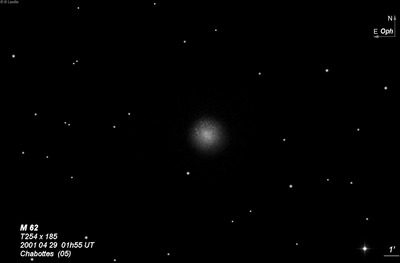
Charles Messier discovered M62 = NGC 6266 = D 627 = h3661 on 7 June 1771 and described a "very beautiful nebula, discovered in Scorpio, it resembles a little Comet, the centre is brilliant & surrounded by a faint glow."
William Herschel first observed the globular on 28 May 1783 with his 6-inch (10-foot telescope) and noted "With 250 power, a strong suspicion, amounting almost to a certainty, of its consisting of stars. In observations with his 18.7-inch (20-foot telescope) in 1785 and 1786, he called the cluster "Extremely bright, round, very gradually brighter in the middle, about 4 or 5' in diameter; 240 power with strong attention showed the stars of it. The cluster is a miniature of the 3d of the Connoissance."
On 8 May 1834, John Herschel was the first to note its off-center core: "globular, vB, L, R, pgvmbM, perfectly resolved with left eye, hardly with right. The most condensed part is a perfect blaze, but not quite in the centre. The southern part runs out further. A beautiful object (See figure 13, Plate VI). [Semi] Diam = 13.5 seconds in RA."
Using the Great Melbourne Telescope on 8 Oct 1874, Joseph Turner called it a "superb object and almost a miniature of Omega Centauri". He noted "this condensed portion is not quite central, but (offset) toward the north-following side, the cluster branching out considerably in the south-preceding direction."
200/250mm - 8" (6/19/82): bright nucleus, nonsymmetrical appearance, fans out to the west from an off-center core. A few very faint stars are resolved at the west edge.
300/350mm - 13.1" (6/19/82): very bright nucleus, asymmetric appearance with a flattened SE region. The outer halo is very mottled and just resolved into many faint stars at 220x.
400/500mm - 18" (7/9/02 - Magellan Observatory, Australia): at 171x this is a very striking globular set in a fine star field. The halo is very irregular and elongated due to a flattening along the SE side. The halo is easily resolved into several dozen faint stars, many in strings and chains. A long string of stars extends from a mag 10.5 star off the SE side along the east edge of the halo. The center appears offset due to the flattening and is very compressed with a large, blazing core.
Notes by Steve Gottlieb